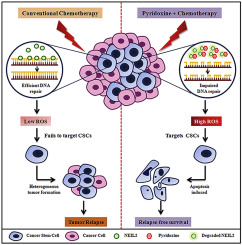当前位置:
X-MOL 学术
›
Free Radical Bio. Med.
›
论文详情
Our official English website, www.x-mol.net, welcomes your
feedback! (Note: you will need to create a separate account there.)
Pyridoxine enhances chemo-responsiveness of breast cancer stem cells via redox reconditioning.
Free Radical Biology and Medicine ( IF 7.1 ) Pub Date : 2020-03-04 , DOI: 10.1016/j.freeradbiomed.2020.02.031 Shruti Banerjee 1 , Shravanti Mukherjee 1 , Apoorva Bhattacharya 1 , Udit Basak 1 , Sourio Chakraborty 1 , Swastika Paul 1 , Poulami Khan 1 , Kuladip Jana 1 , Tapas K Hazra 2 , Tanya Das 1
Free Radical Biology and Medicine ( IF 7.1 ) Pub Date : 2020-03-04 , DOI: 10.1016/j.freeradbiomed.2020.02.031 Shruti Banerjee 1 , Shravanti Mukherjee 1 , Apoorva Bhattacharya 1 , Udit Basak 1 , Sourio Chakraborty 1 , Swastika Paul 1 , Poulami Khan 1 , Kuladip Jana 1 , Tapas K Hazra 2 , Tanya Das 1
Affiliation

|
A plethora of molecular strategies are employed by breast cancer stem cells (bCSCs) to evade chemotherapy-induced death signals, redox modulation being a crucial factor among those. Here, we observed that bCSCs are resistant to DNA damage and generate low ROS upon doxorubicin (Dox) treatment. Further exploration revealed inherently high NEIL2, a base excision repair (BER) enzyme that plays a key regulatory role in repairing DNA damage, in bCSCs. However, its role in modulating the redox status of bCSCs remains unexplored. In addition, Dox not only upregulates NEIL2 in bCSCs at both transcriptional and translational levels but also declines p300-induced acetylation thus activating NEIL2 and providing a protective effect against the stress inflicted by the genotoxic drug. However, when the redox status of bCSCs is altered by inducing high ROS, apoptosis of the resistant population is accomplished. Subsequently, when NEIL2 is suppressed in bCSCs, chemo-sensitization of the resistant population is enabled by redox reconditioning via impaired DNA repair. This signifies a possibility of therapeutically disrupting the redox balance in bCSCs to enhance their chemo-responsiveness. Our search for an inhibitor of NEIL2 revealed that vitamin B6, i.e., pyridoxine (PN), hinders NEIL2-mediated transcription-coupled repair process by not only decreasing NEIL2 expression but also inhibiting its association with RNA Pol II, thus stimulating DNA damage and triggering ROS. As a consequence of altered redox regulation, bCSCs become susceptible towards Dox, which then induces apoptosis via caspase cascade. These findings signify that PN enhances chemo-responsiveness of bCSCs via redox reconditioning.
中文翻译:

吡rid醇可通过氧化还原修复增强乳腺癌干细胞的化学反应能力。
乳腺癌干细胞(bCSC)采用了多种分子策略来规避化疗诱导的死亡信号,氧化还原调节是其中的关键因素。在这里,我们观察到bCSCs对DNA损伤具有抗性,并在阿霉素(Dox)处理后产生低ROS。进一步的研究揭示了bILSC中固有的高NEIL2,这是一种碱基切除修复(BER)酶,在修复DNA损伤中起关键调控作用。但是,其在调节bCSC的氧化还原状态中的作用尚待探索。此外,Dox不仅在转录水平和翻译水平上均上调bCSCs中的NEIL2,而且降低p300诱导的乙酰化作用,从而激活NEIL2,并提供针对遗传毒性药物所施加压力的保护作用。但是,当通过诱导高ROS改变bCSC的氧化还原状态时,抗性群体的凋亡完成。随后,当NEIL2在bCSC中被抑制时,抗性群体的化学敏化可通过受损的DNA修复通过氧化还原重新调节来实现。这表明可能在治疗上破坏bCSC中的氧化还原平衡,以增强其化学反应能力。我们对NEIL2抑制剂的研究表明,维生素B6,即吡ido醇(PN),不仅会降低NEIL2表达,而且会抑制其与RNA Pol II的结合,从而刺激DNA损伤和触发,从而阻碍NEIL2介导的转录偶联修复过程。 ROS。氧化还原调节改变的结果是,bCSC对Dox敏感,然后通过caspase级联反应诱导凋亡。这些发现表明PN通过氧化还原修复增强了bCSC的化学反应性。
更新日期:2020-03-04
中文翻译:

吡rid醇可通过氧化还原修复增强乳腺癌干细胞的化学反应能力。
乳腺癌干细胞(bCSC)采用了多种分子策略来规避化疗诱导的死亡信号,氧化还原调节是其中的关键因素。在这里,我们观察到bCSCs对DNA损伤具有抗性,并在阿霉素(Dox)处理后产生低ROS。进一步的研究揭示了bILSC中固有的高NEIL2,这是一种碱基切除修复(BER)酶,在修复DNA损伤中起关键调控作用。但是,其在调节bCSC的氧化还原状态中的作用尚待探索。此外,Dox不仅在转录水平和翻译水平上均上调bCSCs中的NEIL2,而且降低p300诱导的乙酰化作用,从而激活NEIL2,并提供针对遗传毒性药物所施加压力的保护作用。但是,当通过诱导高ROS改变bCSC的氧化还原状态时,抗性群体的凋亡完成。随后,当NEIL2在bCSC中被抑制时,抗性群体的化学敏化可通过受损的DNA修复通过氧化还原重新调节来实现。这表明可能在治疗上破坏bCSC中的氧化还原平衡,以增强其化学反应能力。我们对NEIL2抑制剂的研究表明,维生素B6,即吡ido醇(PN),不仅会降低NEIL2表达,而且会抑制其与RNA Pol II的结合,从而刺激DNA损伤和触发,从而阻碍NEIL2介导的转录偶联修复过程。 ROS。氧化还原调节改变的结果是,bCSC对Dox敏感,然后通过caspase级联反应诱导凋亡。这些发现表明PN通过氧化还原修复增强了bCSC的化学反应性。











































 京公网安备 11010802027423号
京公网安备 11010802027423号